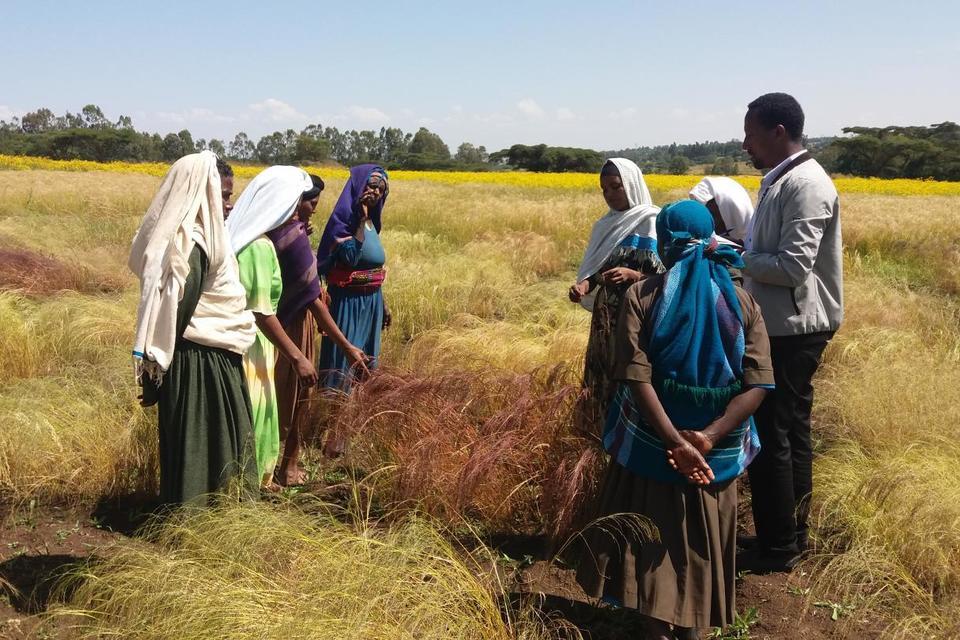Blog Reclaiming the lost glory of sandy soils in Kenya

For a long time, farmers have held on to the belief that sandy soils are not suited to agricultural production. On World Soil Day, we draw the attention to new science-based solutions that are boosting the productivity of sandy soils in a sustainable way.
For a long time, most farmers in Kenya and elsewhere have held on to the belief that sandy soils are not suited to agricultural production. Sandy soils have largely been overlooked owing to their soil texture and structure that rapidly loses water and nutrients from crop root zones, making them inaccessible to the plants. In Kenya, sandy soils are found mainly in the arid and semi-arid areas of eastern and north-eastern parts of the country. In these regions, the vegetation is highly scanty on about 0.1 million hectares of land which would be potentially arable, if some effort were made to improve it.

Maize growing in one of the plots using the surface water retention (SWRT) technology. Credit: JKUATES/S. Muendo
Due to the increasing impact of climate change, farmers experience delayed or too little rains, which compromises the agricultural production in semi-arid regions. Adding to this, one of the major challenges for sandy soils is that, even with irrigation and fertilizer application, the nutrients are quickly washed away and the crops do not benefit from them. For these reasons, most farmers in these areas have given up on farming due to a minimal or a complete lack of harvest in each crop-growing season.
Without working on the water and nutrient retention capacity of soils, returns on farmer investments remain low and the ever-increasing demands for food remain in the deficit. Finding a solution to this situation may partially help meet the internal food demand in Africa, a continent with 51% of the world’s sandy soils.
As we celebrate the World Soil Day, it is important for research centers, governments and investors not to forget about sandy soils. Thankfully, new science is uncovering some potential solutions for these low productive soils. Professor Alvin Smucker, from the Michigan University, observed that not all sandy soils share the same composition. In one farmer’s field, some sandy soils are deep, while in another fields they have a more shallow clay layer that retains highly available water and nutrients in the root zone for longer periods.
To mimic this phenomenon, Prof. Smucker designed the sub-surface water retention technology (SWRT), based on the installation of a protective long-term polyethylene membrane at different depths in sandy soils. The technology has been tested in several countries outside Africa, for example in the USA, Iraq and China, with evidence of up to the three-fold increase in maize yields and other crops.
In Kenya, the technology is implemented through a new project funded by the Nordic Climate Facility. The implementing consortium includes scientists from The Alliance of Bioversity International and CIAT, the Swedish University of Agricultural Sciences (SLU), Jomo Kenyatta University of Agriculture and Technology (JKUAT) together with partners from JKUAT Enterprises (JKUATES) and SWRT Solutions Ltd in USA. Together, we are piloting the technology on selected farmer fields in Mtito Andei, Makueni County, where the agricultural officers from the County Government and the Kenya Agricultural and Livestock Research Organization (KALRO) are supporting with the local knowledge.
As part of this initiative, Prof. Smucker trained 20 young people and a few selected farmers from the region on the SWRT technology. To date, the new technology membranes have been installed on on 14 farms in Kibwezi and we are targeting to reach 20 farms with the technology for demonstration purpose in the region. This work is carried out by 11 youths in the regions, whose capacity was developed within the project and are now experts in installing the SWRT membranes.

Kenya – Ongoing installation of SWRT membranes in one of the demonstration plots. Credit: CIAT
The goal of this conversion of sandy soils into sustainable agricultural productive resources is to demonstrate how arid regions of Kenya can benefit smallholder farms. This project provides opportunities for farmers from outlying regions to learn how to turn their low production soils into more profitable resources, during widely announced field demonstration days. This technology represents a gateway to reclaiming sandy soils, which have the potential to increase farmers’ livelihoods and consequently improve their well-being of their entire communities.
Working closely with the Ministry of Agriculture and other county and national agricultural bodies, the data collected about SWRT-improved sandy soils will be used to explore how to scale up this technology sustainably in other regions of the country and beyond, in order to improve soil quality and enhance crop production. In particular, a business strategy will be developed by JKUATES to ensure that SWRT provides solutions that mitigate the environmental, economic and social challenges facing smallholder farmers.
The author: Ms. Sylvia Nyawira is a crop and soil carbon modeler at the Alliance of Bioversity International and International Center for Tropical Agriculture (CIAT).
The author greatly appreciates the support provided by Rosemary Nzuki, Libére Nkurunziza, Alvin Smucker, Stanley Karanja and Shem Kuyah with the development of this blog.
This project is carried out under the CGIAR Research Program on Water, Land and Ecosystems (WLE)


